What’s inside this article: A brief overview of the vestibular system, which is stimulated by hanging upside down, followed by the benefits of hanging upside down and a list of child-friendly activities you can try.
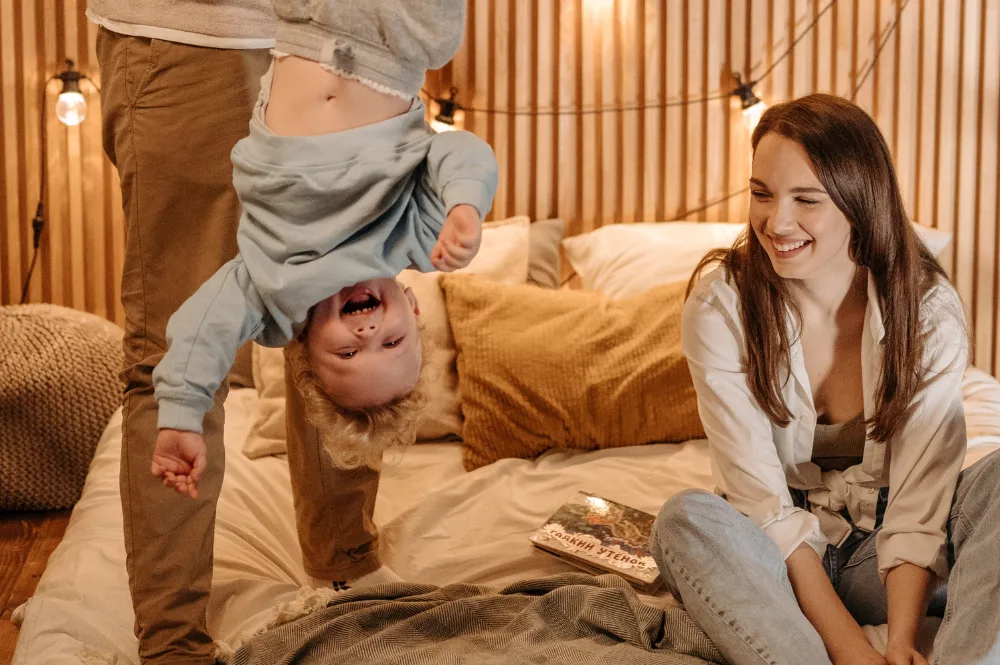
Hanging upside down might seem like mere child’s play. Yet, this simple action has more benefits than you may realize. In fact, it may play a vital role in self-regulation for sensory-seeking kiddos.
This article looks in more detail at the vestibular system, how hanging upside down sparks it, and then shares a roundup of fun and engaging child-friendly activities to explore.
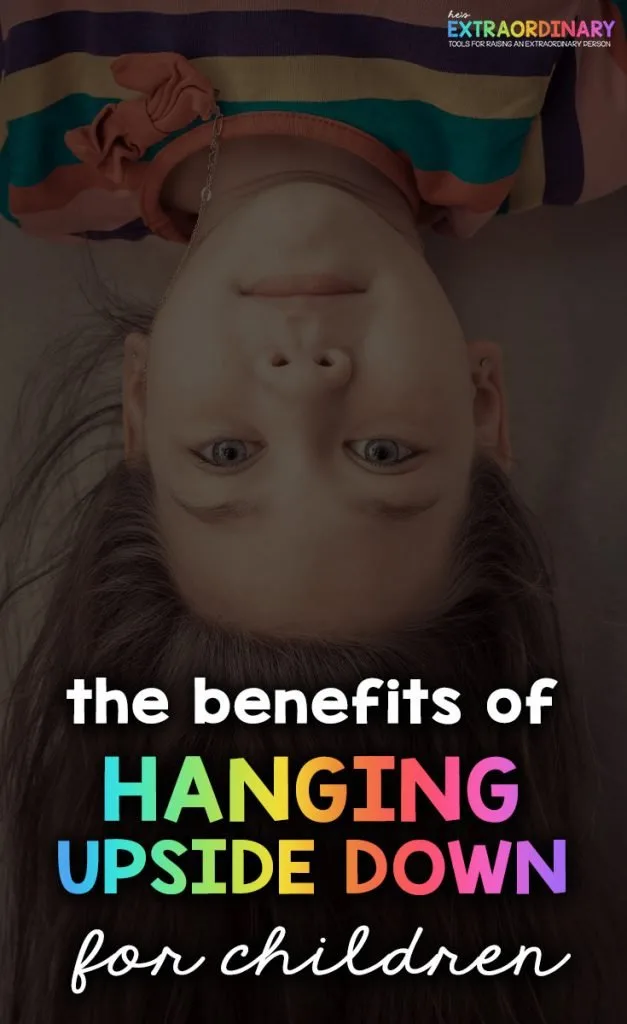
Understanding The Vestibular System
Before diving into the myriad benefits of hanging upside down, it’s essential to grasp the concept of the vestibular system.
What Exactly is the Vestibular System?
Often overlooked in comparison to our primary senses like sight and taste, the vestibular system is an integral sensory system contributing to:
- Balance
- Motor planning
- Motor skills
- Coordination
- Posture
- Body and Spatial Awareness
Originating in our inner ear, every twist, turn, or head tilt activates this system. If you’d like to read the full details of its functionality, check out this article: here.
Recognizing the signs of vestibular-seeking behaviors in children is crucial.
Vestibular Seeking Behaviours: Spotting The Signs
Children with an under-responsive vestibular system often display behaviors like:
- Restlessness and inability to sit still
- Always in motion, movements are quick, for example, never walks, only runs
- Acts impulsively
- Tendency to play rough or rambunctiously
- Sitting in unconventional positions, such as with feet elevated or upside down
- Frequently bumping into objects or people, seemingly unaware
- Displaying a lack of awareness about their strength, sometimes inadvertently causing harm to others
- Constant fidgeting or rocking, even when attempting to sit quietly
When children excessively seek vestibular input, it may seriously interfere with their functioning on a daily basis.
It’s nearly impossible for a child to sit still and concentrate at school when their vestibular system is under-responsive.
Benefits of Hanging Upside Down
You might’ve noticed kids hanging upside down, engrossed in conversations or just observing the world from a unique perspective.
Well, their innate instincts are pointing them to numerous advantages:
- Calms and regulates the nervous system
- Delivers distinctive vestibular input
- Offers both calming and alerting effects
- Helps avoid sensory overload and consequent meltdowns
- Eases back pain and promotes spinal health
- Enhances brain function
Moreover, these benefits can last for hours, making periodic short bursts of upside-down fun a potent tool for sensory stimulation.
Although there can be risks involved if inverting the head for extended periods of time, generally speaking, kids can hang upside down as often as they like, as long as you are following their cues.
If at any time your child indicates that they don’t want to be upside down or they complain of feeling dizzy, you should stop immediately.
Activities That Involve Hanging Upside Down
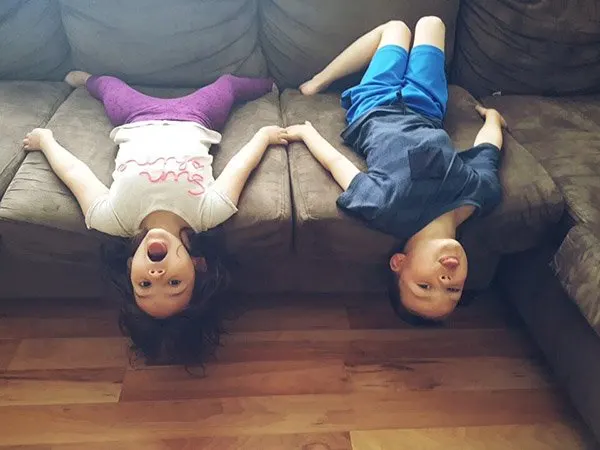
There are a lot of different ways you can fit inverting the head into regular play with your kids.
Here are some ideas to get you started:
- Hanging upside down from the couch
- Children’s Yoga
- Hanging from the monkey bars
- For younger children, you can set them on your lap facing you and hold their hands while you let them drop back upside down over your knees and then pull them back up.
- Lean backward over a large exercise ball.
- Gymnastics and tumbling: cartwheels, forward and backward rolls, bridge walking, etc., all involve inverting the head
- Get an indoor trapeze bar – so your kiddo can hang upside down in the house (mounts onto door frame) as much as they like! (Seriously, this thing is AWESOME and will help save your sanity if you feel as crazy as I do when you watch your child leap and roll all over the sofa.)
- Inversion Swings or Hammocks: Install a safe inversion swing or hammock at home or in the garden where kids can safely swing and hang upside down under supervision.
- Aerial skills or circus arts: there are classes where kids can learn beginner’s trapeze or how to perform various poses and sequences while suspended from silk fabrics, including upside-down positions.
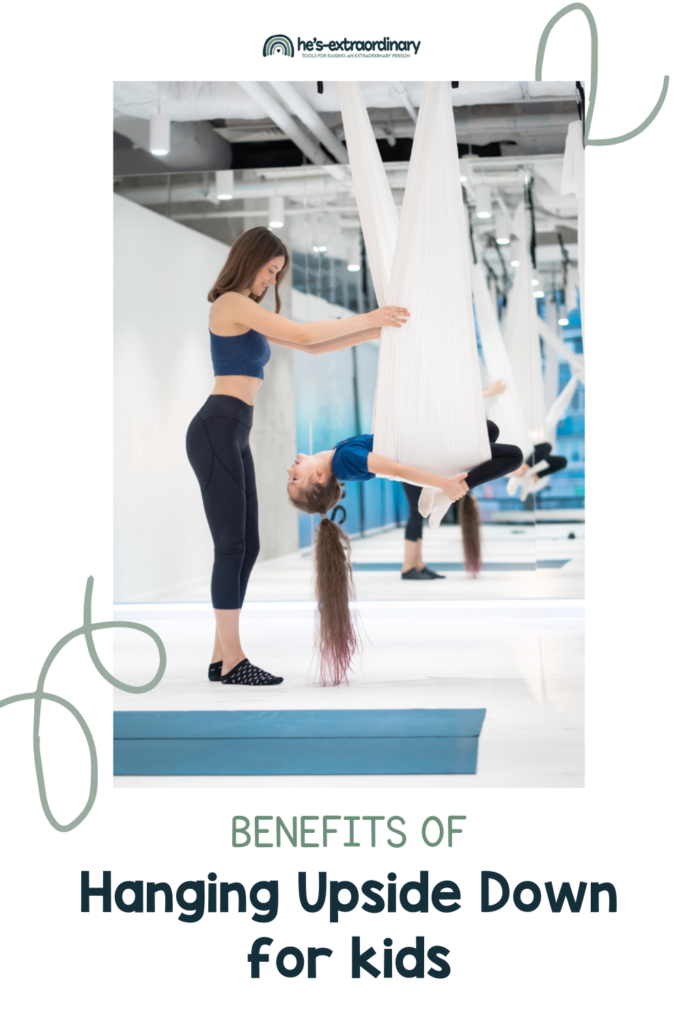
Other Vestibular Input Activities
Hanging upside down is not the only thing that stimulates the vestibular system – although it is one of the most effective and unique experiences.
Other activities and games you can play include:
- Freeze dance (one of our favorites) – everybody dances really fast to the music, and then when the song pauses, you freeze! No matter what silly position you were in.
- This 7-minute HIIT workout
- Riding a bike
- Playing on the swings and slides at the playground
- Swimming (also a great proprioceptive activity)
- Rhythmic bouncing or rocking on your lap
- Jumping on a trampoline
- Pulling your child around the floor on a blanket
- Crashpad
- Playing ring-around-the-Rosie
- This morning workout for kids
- Basically, anything that involves moving your body, especially your head.
If you’d like even more ideas for sensory activities, read: 52 Vestibular Input Activities for Sensory Seekers
What About Spinning?
Rolling down hills or spinning in circles are kid favorites. Why? They’re tapping into the vestibular system. But remember:
- Slow, methodical spinning can soothe.
- Rapid, abrupt spins might overstimulate.
Always keep an eye out and follow your child’s cues. Some kids can spin forever, and they’ll never feel dizzy, others can barely play a game of ring-around-the-rosie.
If your child doesn’t enjoy or react well to an activity like spinning or hanging upside down, don’t force them to participate. Everybody processes input differently.
Be Proactive
One of the best ways to avoid sensory-seeking behavior, and meltdowns, is to be proactive. Regular sensory breaks and hanging upside down can improve your child’s focus and prevent excessive hyperactivity throughout the day.
Check out this 7-minute morning activity for kids that can help improve self-regulation.
Plus discover some more excellent strategies for proactively preventing meltdowns here.
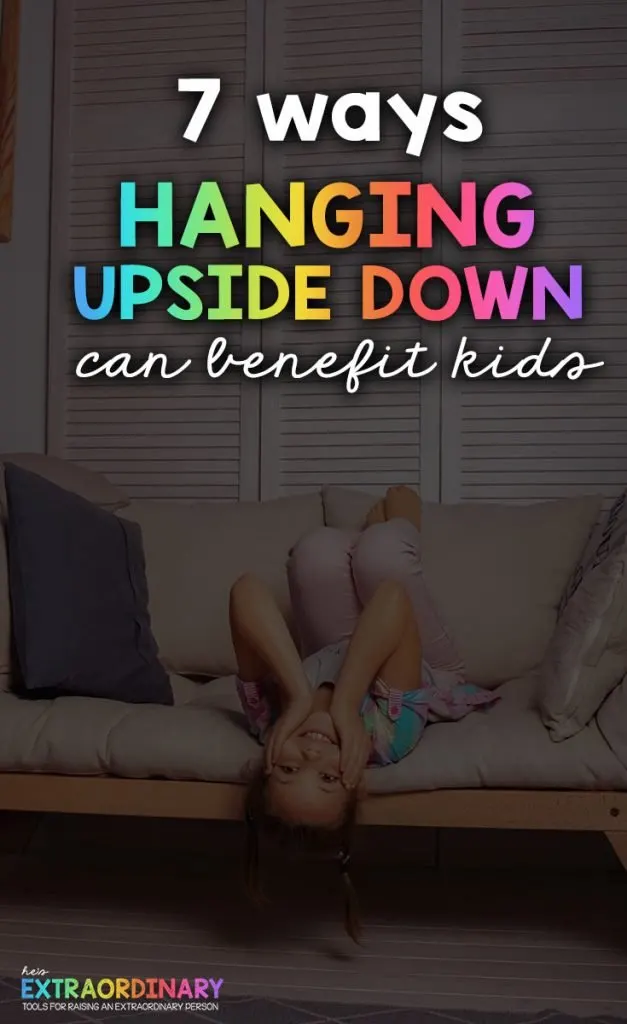


8 Minute Morning Workout for Kids - ADHD & Autism Resources for Parents
Saturday 30th of November 2019
[…] should be looking down so your head is completely inverted. Hold the pose for 45 seconds, or for the full minute, if you […]
Furniture that Doubles as Sensory Equipment
Tuesday 19th of November 2019
[…] Another way we use our couch is a comfortable way to invert the head. Again, when a child is upside down, they’re getting lots of vestibular input to the inner ear that can help calm and regulate. Learn more about the calming benefits of hanging upside down HERE. […]
The Best Gift Ideas for Autistic Children - Raising an Extraordinary Person
Sunday 10th of November 2019
[…] to create the sensory room of my dreams, this will be a must-have. My kids love to spin, roll and go upside down. The barrel roll does all that while encouraging sensory integration, balance, and gross motor […]
Being Upside down has surprising benefits you'll want to know about |
Thursday 19th of September 2019
[…] sensory activities that involve hanging upside down may provide the stimulation necessary for preventing sensory related meltdowns. One of the best ways to avoid sensory seeking behavior when it is disruptive or unsafe, and […]